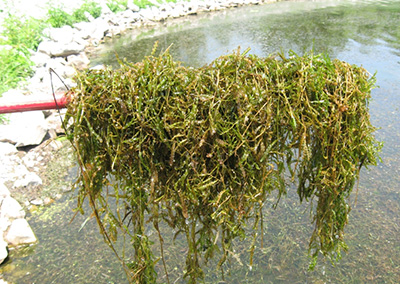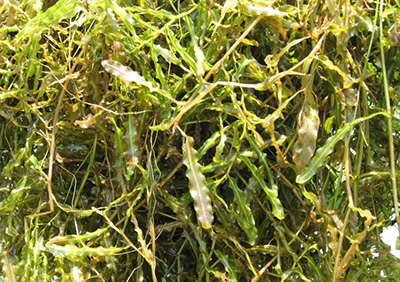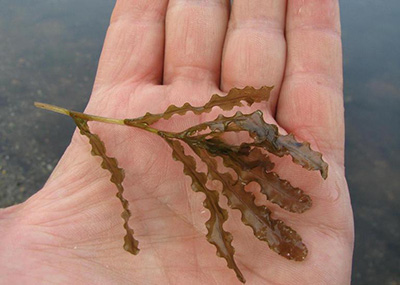Stem
- 1-15 ft. long, flattened and channeled; branching can increase at the end of the stem, leading to matting

Curlyleaf pondweed
Leaves
- Olive green to reddish brown, slightly translucent; alternate, sessile, 1.5-4 in. long, narrow, with toothed margins; leaf margins are wavy with a conspicuous mid-vein; leaf tips are rounded or blunt

Curlyleaf pondweed
Flower
- Green inconspicuous flowers; stalk supporting the flower will grow 1 in. above water surface; seeds are nutlet-like structures

Curlyleaf pondweed leaves
Root
- Rhizomes, pale yellow or reddish; will root at the nodes
Other
- Grows in ponds, lakes, streams, rivers, reservoirs, irrigation ditches and marshy areas; known to occur in Churchill, Douglas, Elko and Lyon counties
- Perennial; grows as submersed aquatic plant; will grow from shore out to depths of 15 ft.
- Spreads aggressively from fragments of roots and stems; produces seed, but seedlings rare
Control
- Mechanical harvesting can reduce plant density, but plants re-sprout from stem fragments; bottom barriers can be used to smother infested areas
- Chemical controls must be labeled for water use: diquat, endothall, flumioxazin, fluridone, imazamox and others; check label for rates and water temperature requirements; large infestations should be treated a portion at a time to prevent low oxygen levels as plants decompose
Blecker, L., Creech, E., Dick, J., Gephart, S., Hefner, M., Kratsch, H., Moe, A., Schultz, B.
2020,
Nevada Noxious Weed Field Guide – Curlyleaf pondweed,
Extension, University of Nevada, Reno, Field Guide


